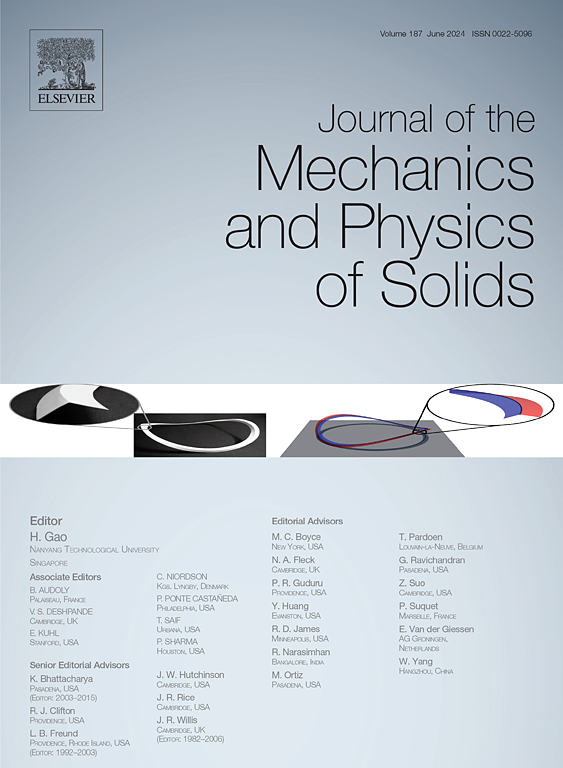Description of void coalescence by internal necking/shearing within XFEM via a micromechanical 3D volumetric cohesive zone model (μ-VCZM)
IF 6
2区 工程技术
Q2 MATERIALS SCIENCE, MULTIDISCIPLINARY
引用次数: 0
Abstract
This work addresses ductile failure in engineering structures, particularly in aerospace, naval, automotive, and nuclear industries. During accidental overloading or metal forming, materials such as titanium and aluminum alloys experience plastic deformation and ductile damage (by void nucleation, growth, and coalescence) that may eventually lead to crack propagation and fracture. The present study concentrates explicitly on the void coalescence stage. Indeed, building upon a numerical methodology developed by the present authors and detailed in a companion paper, a novel micromechanics-based volumetric cohesive zone model (-VCZM) is incorporated within the Extended Finite Element Method (XFEM) to reproduce the process of void coalescence while overcoming the mesh objectivity issues of the numerical results during the softening regime. The Mode I (extension) and Mode II (shear) coalescence onset criteria and evolution laws are derived from micromechanical considerations. Subsequently, the yield surfaces and the integration algorithm necessary to determine the stress state within the coalescence band are established. Finally, the micromechanics-based -VCZM is applied within the XFEM-VCZM unified methodology. The numerical model, implemented as user element (UEL) into the computation code Abaqus, demonstrates efficacy in replicating the stages of ductile fracture, highlighting its potential for addressing complex finite strain three-dimensional boundary value problems. Notably, the results obtained with coarse meshes exhibit no mesh dependency below a specific mesh size, reproducing realistic Mode I and II fracture surfaces.
基于微力学三维体积黏聚区模型(μ-VCZM)的XFEM内缩/剪切孔洞聚并
这项工作涉及工程结构的延性破坏,特别是在航空航天,海军,汽车和核工业。在意外超载或金属成形过程中,钛和铝合金等材料会经历塑性变形和延性损伤(由空洞成核、生长和聚并),最终可能导致裂纹扩展和断裂。目前的研究主要集中在孔洞合并阶段。事实上,在本文作者开发的一种数值方法的基础上,在扩展有限元法(XFEM)中纳入了一种新的基于微力学的体积内聚区模型(μ-VCZM),以重现空洞合并的过程,同时克服了软化过程中数值结果的网格客观性问题。从微观力学角度推导出ⅰ型(伸展)和ⅱ型(剪切)聚结的发生准则和演化规律。随后,建立了屈服曲面和确定聚结带内应力状态所需的积分算法。最后,将基于微力学的μ-VCZM应用到XFEM-VCZM统一方法中。该数值模型以用户单元(UEL)的形式在计算代码Abaqus中实现,证明了在复制韧性断裂阶段方面的有效性,突出了其解决复杂有限应变三维边值问题的潜力。值得注意的是,使用粗网格获得的结果显示,在特定网格尺寸以下没有网格依赖性,可以再现真实的I型和II型裂缝表面。
本文章由计算机程序翻译,如有差异,请以英文原文为准。
求助全文
约1分钟内获得全文
求助全文
来源期刊
CiteScore
9.80
自引率
9.40%
发文量
276
审稿时长
52 days
期刊介绍:
The aim of Journal of The Mechanics and Physics of Solids is to publish research of the highest quality and of lasting significance on the mechanics of solids. The scope is broad, from fundamental concepts in mechanics to the analysis of novel phenomena and applications. Solids are interpreted broadly to include both hard and soft materials as well as natural and synthetic structures. The approach can be theoretical, experimental or computational.This research activity sits within engineering science and the allied areas of applied mathematics, materials science, bio-mechanics, applied physics, and geophysics.
The Journal was founded in 1952 by Rodney Hill, who was its Editor-in-Chief until 1968. The topics of interest to the Journal evolve with developments in the subject but its basic ethos remains the same: to publish research of the highest quality relating to the mechanics of solids. Thus, emphasis is placed on the development of fundamental concepts of mechanics and novel applications of these concepts based on theoretical, experimental or computational approaches, drawing upon the various branches of engineering science and the allied areas within applied mathematics, materials science, structural engineering, applied physics, and geophysics.
The main purpose of the Journal is to foster scientific understanding of the processes of deformation and mechanical failure of all solid materials, both technological and natural, and the connections between these processes and their underlying physical mechanisms. In this sense, the content of the Journal should reflect the current state of the discipline in analysis, experimental observation, and numerical simulation. In the interest of achieving this goal, authors are encouraged to consider the significance of their contributions for the field of mechanics and the implications of their results, in addition to describing the details of their work.

 求助内容:
求助内容: 应助结果提醒方式:
应助结果提醒方式:


